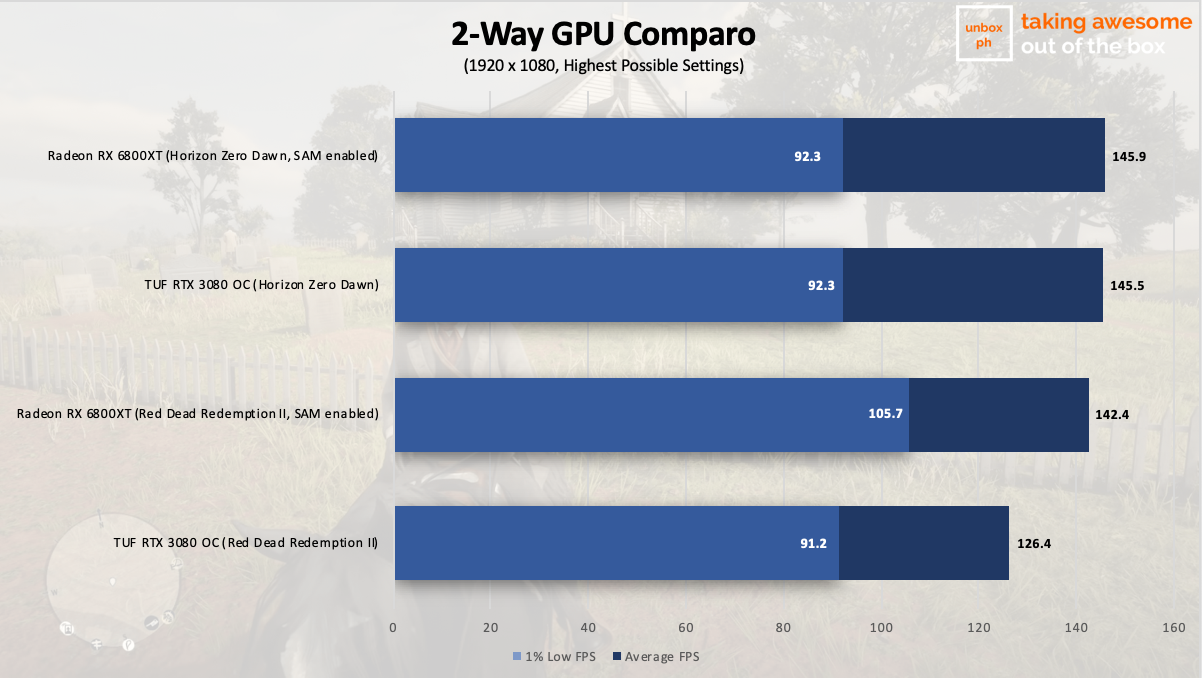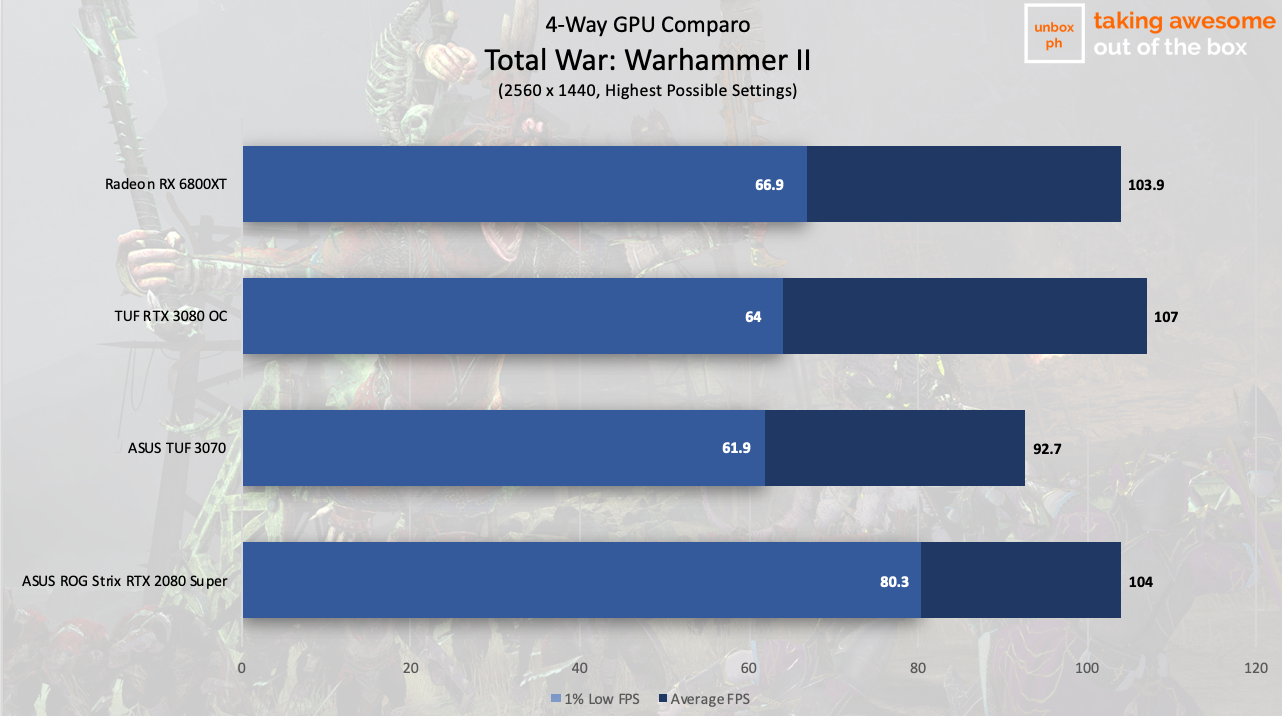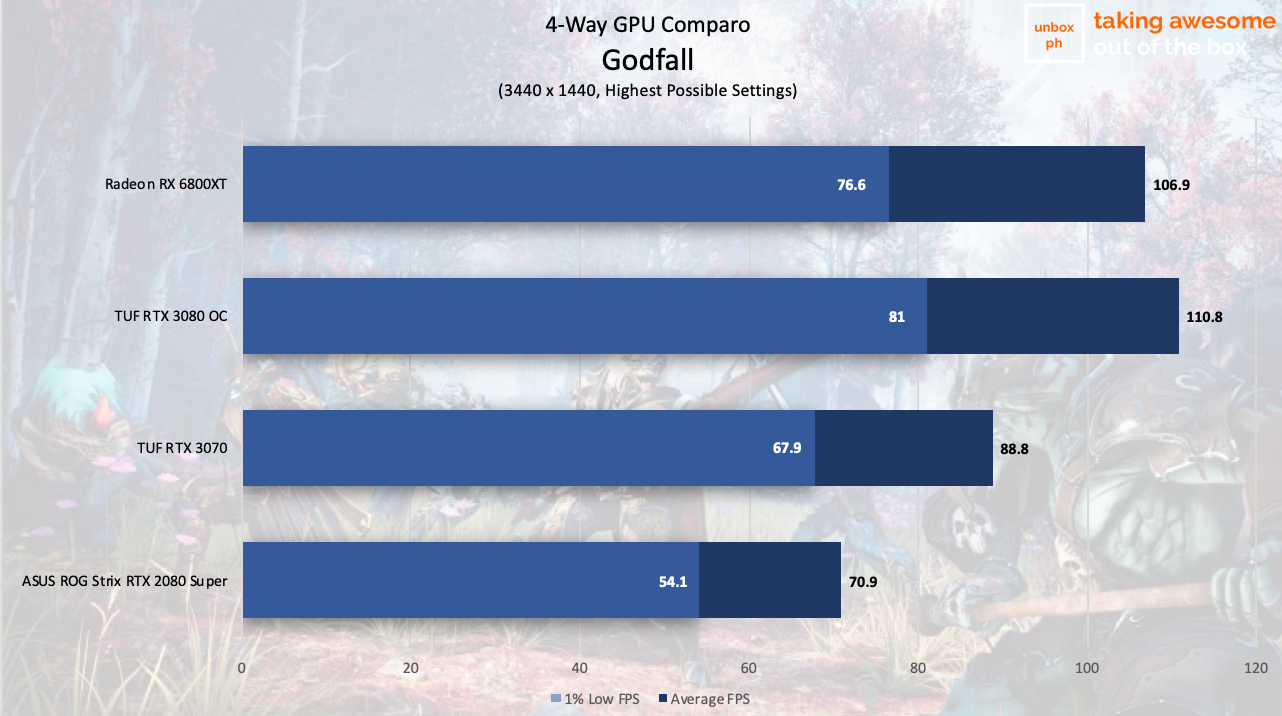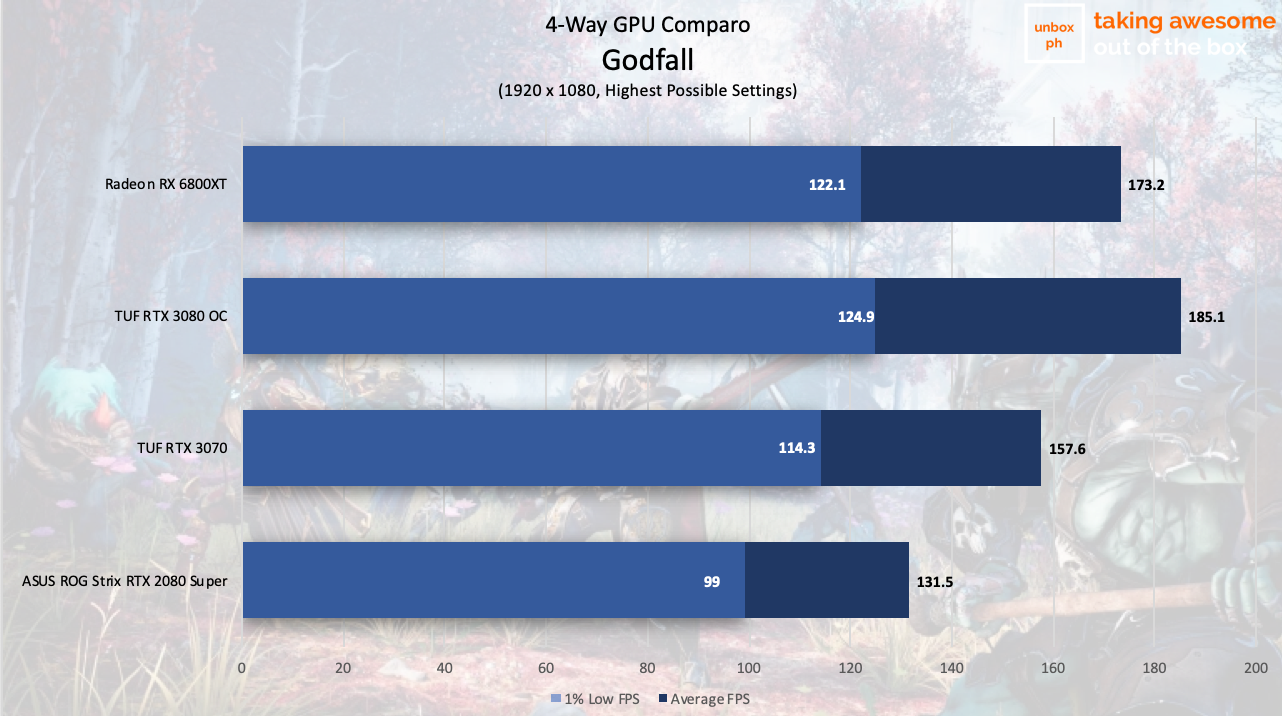
Verdict: AMD is finally back at the top-end of the GPU market, going toe to toe with NVIDIA with the AMD Radeon RX 6800XT. While it’s not a complete blowout like what the company did with rival Intel in the processor space, AMD’s new flagship GPU manages to trade blows with the GeForce RTX 3080, something that we thought we would never see this year.
The fact that AMD managed to achieve that while using less power and pricing their offering lower than the competition speaks volumes about the company’s technological prowess.
Pros
- Cheaper MSRP than the RTX 3080
- Uses less power than the RTX 3080
- Delivers better performance with AMD CPUs via SAM
- Trades blows with the RTX 3080 in many games
Cons
- Runs a little hot
- Ray-tracing performance isn’t quite up to par compared to the RTX 3080
AMD’s closing out the year with the official launch of their new Radeon 6000 series of GPUs, with today’s review revolving around the company’s flagship, the Radeon RX 6800XT. Going into the review I was very skeptical of AMD’s performance claims VS the competition, especially since the new GPUs are built on the same 7nm TSMC process that their RX 5000 series uses. That means all of the substantial performance gains that the company promised for the new cards were all achieved via architectural improvements, which is a monumental effort at the very least. But as you’ll find out in this review, AMD delivered on those claims and is finally competing on the top end of the GPU market after years and years of dominance by rival NVIDIA.

Packaging and contents:
The Radeon RX 6800 XT comes in a very spiffy box with a glamor shot of the card outside and has a welcome note from the company on the opposite side of the lid when you open it.


Inside the box sits the card itself along with documentation. Unlike phones and other devices, GPUs don’t really ship with fancy packaging and a lot of extras, though AMD going through the trouble to highlight their new baby is a nice touch for people who will opt to go with their reference design on day 1.

Design
Before we dive into talk about what makes the Radeon RX 6000 series of GPUs special this time around, let’s talk about the Radeon RX 6800XT specifically first.
This is the top-end of the 6000 series line (at least until the RX 6900XT comes out), and features a large 2.5-slot design along with a triple-fan cooler. It’s 267mm long, and 120mm in height. The backplate is colored silver, which is a nice contrast to the black fins. While it is a tad long, if your case is capable of housing a non-reference RTX 3080 as the ASUS TUF RTX 3080 OC, then it’ll be able to fit the reference RX 6800XT just fine.

The card is very chunky and thick, and heavy too – weighing in at around 1.5 kilos. I generally don’t endorse anti-sag devices but for this big boy, I’ll make an exception.
One thing that’s striking about the card itself is that there’s few, if any, traces of plastic in the build. There are only two places where we could see that AMD used plastic in the construction, and that’s the fan and power connectors. Everything else is made out of metal, which I really like.

The overall design motif is pretty nice to look at too, and the black and silver scheme with red accents look really good inside our case. The Radeon logo lights up red, though there’s no RGB here.

Unlike the reference card of NVIDIA for their RTX 3000 series, AMD’s RX 6000 series uses non-specialized, 8-pin (x2) power connectors to deliver power. That means you don’t need a power adapter or specialized power connectors to connect to it, leading to neater cable management.

As for connectors, you’re looking at 2 x DP 1.4, 1 x HDMI 2.1, and a single USB-C connector.

Architecture
Time to talk about AMD’s RDNA 2 architecture, which is what the new Radeon RX 6000 series cards are built on. Unlike NVIDIA with Ampere, AMD’s new crop of cards is still built on the same 7nm process that they utilized for their RX 5000 family. That means any improvements that the cards get are all the result of just architectural improvements.
If that sounds familiar, that’s because it’s essentially the same playbook they used for their new Ryzen 5000 series of processors. Same 7nm process node – just a complete redesign of the architecture.

Let’s start with the Compute Units or CUs. In (very) layman’s terms, a compute unit is equivalent to a core in a processor, with the Radeon RX 6800XT sporting 72 CUs total. AMD has spent considerable time on making the CUs streamlined for increased frequency and lower power draw, which increases overall data transfer efficiency.
I’m not going to bore you with the technical details as you can find other places that can explain it better, but essentially AMD has managed to refine RDNA 2 to the point that the GPU can take higher clocks with the same amount of power compared to RDNA 1. This refinement is responsible for AMD’s claims of comparable performance to NVIDIA’s RX 3080 VS the Radeon RX 6800XT while consuming less power.

Aside from refinements to the CU, AMD also introduced Infinity Cache. It’s a way for AMD to use a smaller 256-bit memory bus and slower GDDR6 memory on their new cards without sacrificing performance VS NVIDIA’s RTX 3000 series which uses faster and better GDDR6X memory as well as a bigger bus. To put it simply, it’s a bandwidth amplifier, and this 128MB Infinity Cache is able to give up to 3.25x the effective bandwidth of 256-bit of GDDR6 memory.
Using Infinity Cache also means less latency to memory, reducing it by 48% compared to the 5700XT.

One very unique value proposition for AMD’s GPUs is their ability to leverage their Ryzen 5000 CPUs with the Radeon RX 6000 series of GPUs via Smart Access Memory, or SAM.
SAM allows the CPU to have direct access to the memory on the GPU, bypassing the usual 256MB limit that’s usually present, improving performance, which should also result in higher frames.
You will have to be all-in with AMD to enjoy this though, as you need a Ryzen 5000 series processor, run a 500 series motherboard (like a B550 or X570), and a Radeon RX 6000 series GPU to enjoy SAM. Is it worth it? Well, I’m pre-empting a few of my benchmarks here, but you’ll be seeing at least 5%-15% improvements in games, though the increase is very game dependent.
One feature that you can enjoy without needing an AMD CPU is Rage mode, as well as ray tracing thanks to DXR ray tracing and DirectX 12 Ultimate.
Rage mode is a performance tuning preset that’s accessible through Radeon Software Adrenalin. While it sounds like an easy OC mode, it simply raises the power and fan-speed limits of the card to take advantage of any available thermal headroom for increased performance. The amount of added performance you get varies greatly depending on a number of factors, including ambient temperature as well as the cooling performance of whatever AIB you go with. We didn’t have time to run Rage mode along with our benchmarks below, but we’ll do a revisit once we have more time.

New for the Radeon line is the ability to finally use DirectX Raytracing (DXR) via high-performance Ray Accelerators. Ray Tracing has been present in NVIDIA’s RTX lineup since its Turing architecture, and it’s nice to finally see that feature on AMD’s offering. There are 72 Ray Accelerators on the RX 6800XT – finally giving AMD’s GPU feature parity with NVIDIA.
There are a few more technologies present on the RX 6800XT that we simply don’t have time to dive into, like Variable Rate Shading, Radeon Anti-lag, Radeon Boost, FidelityFX, and a bunch more. We’ll be coming back to these at a later article if time allows, but for now, we’ll be taking a look at the performance metrics of the new card VS a couple of games.

Performance and benchmarks
We’ve finally reached the section that matters: performance. Before we dive in, let’s take a look at the specs of the AMD Radeon RX 6800XT above.
For our test system, we’re using AMD’s own Ryzen 9 5950X processor, along with 16GB of T-Force XTREEM ARGB 3200MHz memory, AORUS NVMe Gen4 SSD (2TB), and a Cooler Master ML240L AIO.
We’ve added two new games to the test gaming suite for this review, both provided by AMD. Dirt 5 is a showcase of how well ray tracing works when a studio works closely with the company with their tech, which explains its ray tracing lead VS NVIDIA’s offerings. Godfall meanwhile has AMD’s FidelityFX built-in, though again we won’t be diving into that right now. The fact of the matter is that companies like AMD and NVIDIA work closely with game studios for them to adapt and adopt their tech for their games, which is evident in the poor showing for the Radeon RX 6800XT’s ray tracing performance in games like Control, NVIDIA’s go-to title to show off tech like DLSS.
Also take note that while we did have an RTX 3080 card to pit against the Radeon RX 6800XT, it was an OC variant that had a small factory overclock applied that skews the scores anywhere around 3%-5% in it’s favor. It’s a small performance gain yes, but it’s important to keep that in mind as we compare performance.

First off, synthetic benchmarks. Here the RX 6800XT has a small lead VS the RTX 3080 except for ray tracing. As it stands in synthetic tests, the RX 6800XT has roughly equivalent ray tracing performance as the RTX 3070.
Moving on to gaming benchmarks, it looks like the NVIDIA RTX 3080 is the winner by a hair on the tests, but if you factor in the additional performance gain of the OC model of the card we’re reviewing VS a reference model, there are many titles where both cards are neck to neck in performance if you account for the 1-2% run-to-run variance in FPS.
What the RTX 3080 does have over the RX 6800XT is ray tracing performance. NVIDIA has a lead over AMD in that regard, and in two of the three titles that we tested with ray tracing on and off, you can really see the performance hit that the RX 6800XT is saddled with.


In titles like Dirt 5 however where AMD worked with the game studio, the performance difference isn’t that big, but it’s still there.


What’s really interesting here is that if you have the hardware required for SAM, as we did, then you can see the RX 6800XT match, and sometimes exceed, the performance of the RTX 3080, even if you take into account the slight OC of the card we used.


As for actual performance gains, we’re seeing at the very top end around 14.19% for some games at some resolutions (RDR2, 1080p), and as little as 1% for games like Control. Typically you’re probably going to see an average of 5% increase with SAM here, though again, it varies game by game. As AMD makes more headway into the high-end GPU market that might change as more studios partner with them in the future.
Power and thermals
After all that AMD has done to improve the performance of the card, it’s remarkable that the company has managed to keep to the 300W TDP promise of their cards, which is less than the 320W TDP of the NVIDIA RTX 3080.
As for thermals though, that’s another story. We recorded maximum thermals of around 83 degrees Celcius during our tests, which is a little high, even with the new cooler design. This was in a room with a 30 degree Celcius ambient.
Part of the cause for this higher thermal is the rather conservative fan curve for the GPU. With a more aggressive fan curve, we managed to drop that down to around 79 degrees Celcius, but that’s still pretty toasty.
Take note that AMD says the cards have a 110-degree “junction” temperature, and the card still has thermal headroom to boost up to that with our normal use for Rage mode.

Conclusions and wrap up
AMD has managed to gain parity with NVIDIA’s top-end offering, finally putting the screws and threatening the green team’s dominance in the top-end of the GPU sphere.
When rumors of the arrival of AMD’s new cards we rife earlier this year, many people would have been happy if it approached RTX 2080 Ti levels of performance. AMD delivered on its promise for an RTX 3080 competitor, and NVIDIA needs to take note.
Ray-tracing performance isn’t there yet, but for many people, that’s not such a big deal.
There’s still plenty we haven’t explored here, and there’s a huge potential in the card for overclocking and further optimization by AMD’s AIB partners like ASUS, MSI, and the like.
The AMD Radeon RX 6800XT is priced at $650 for the reference model, though it’s not clear right now if it’ll be offered here in the Philippines. Take note though that third-party designs from ASUS and all of AMD’s other partners will be launched soon – it’ll be interesting to see how far they can take the RX 6800XT with their cooling solution in the coming weeks.
AMD should be proud of themselves for what they’ve achieved – not only have they managed to catch up (and beat) Intel with their Ryzen 5000 series of processors, they’ve now managed to catch up with NVIDIA too at the top end.







































